MGMT 20143: Business Model Analysis of Ingogo and Recommendations
VerifiedAdded on 2022/09/08
|15
|2599
|11
Report
AI Summary
This report provides a comprehensive analysis of Ingogo, an Australian online taxi booking company, using the Business Model Canvas framework. It deconstructs Ingogo's business model, identifying key partners such as ATIA, Canaccord Genuity Corp., and the Federal Government of Australia. The report examines key activities, value propositions like automated receipts and no surge pricing, and customer relationships through websites and mobile applications. It also highlights critical success factors, including marketing improvements and emission controls, while also evaluating factors impacting the business model's success such as funding and professional development. Furthermore, the report suggests changes, such as enhancing social media presence and expanding revenue streams into online food delivery. In conclusion, the report emphasizes the importance of marketing, environmentally sustainable business practices, and increased funding for Ingogo's future success in the online taxi booking industry.
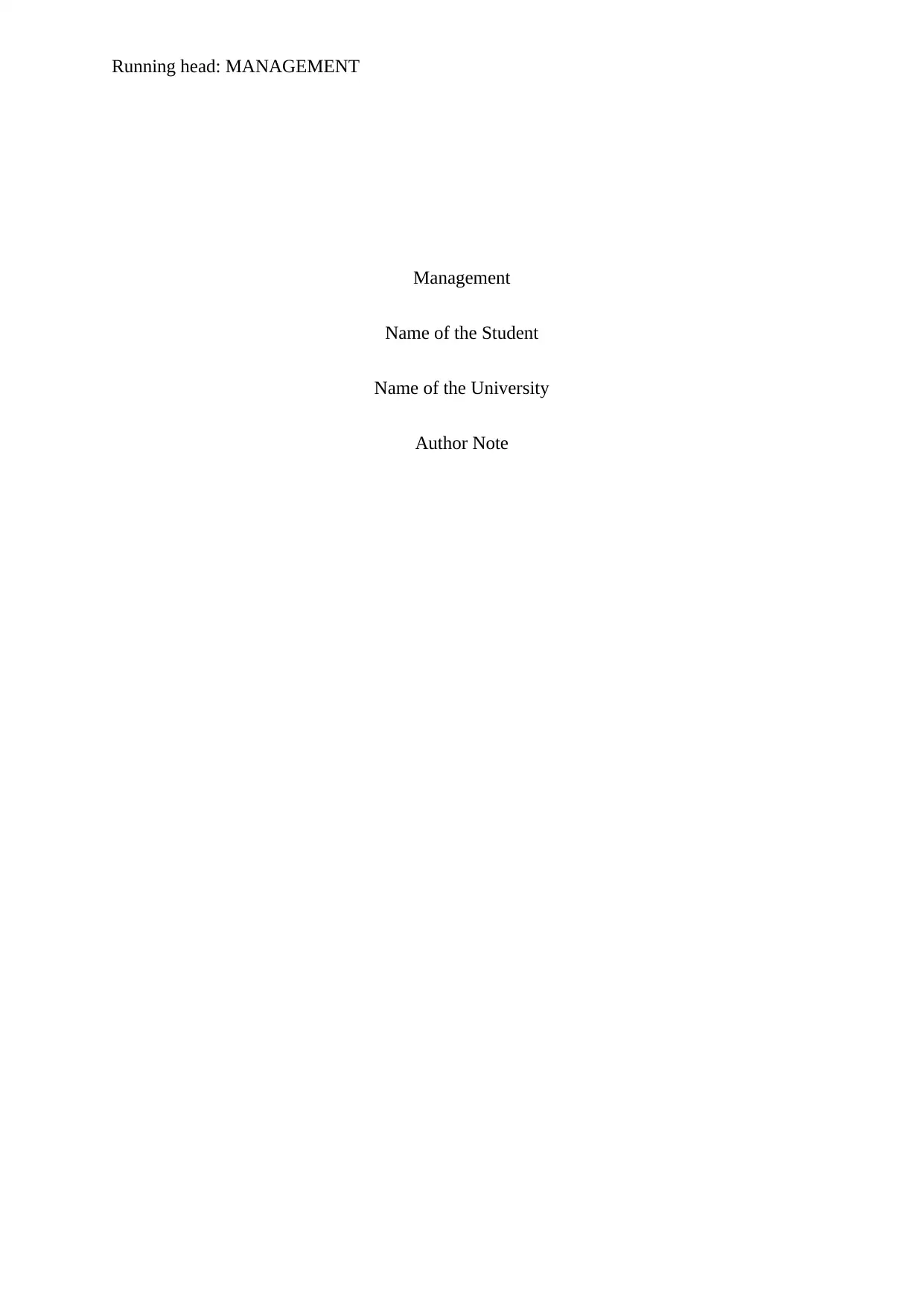
Running head: MANAGEMENT
Management
Name of the Student
Name of the University
Author Note
Management
Name of the Student
Name of the University
Author Note
Paraphrase This Document
Need a fresh take? Get an instant paraphrase of this document with our AI Paraphraser
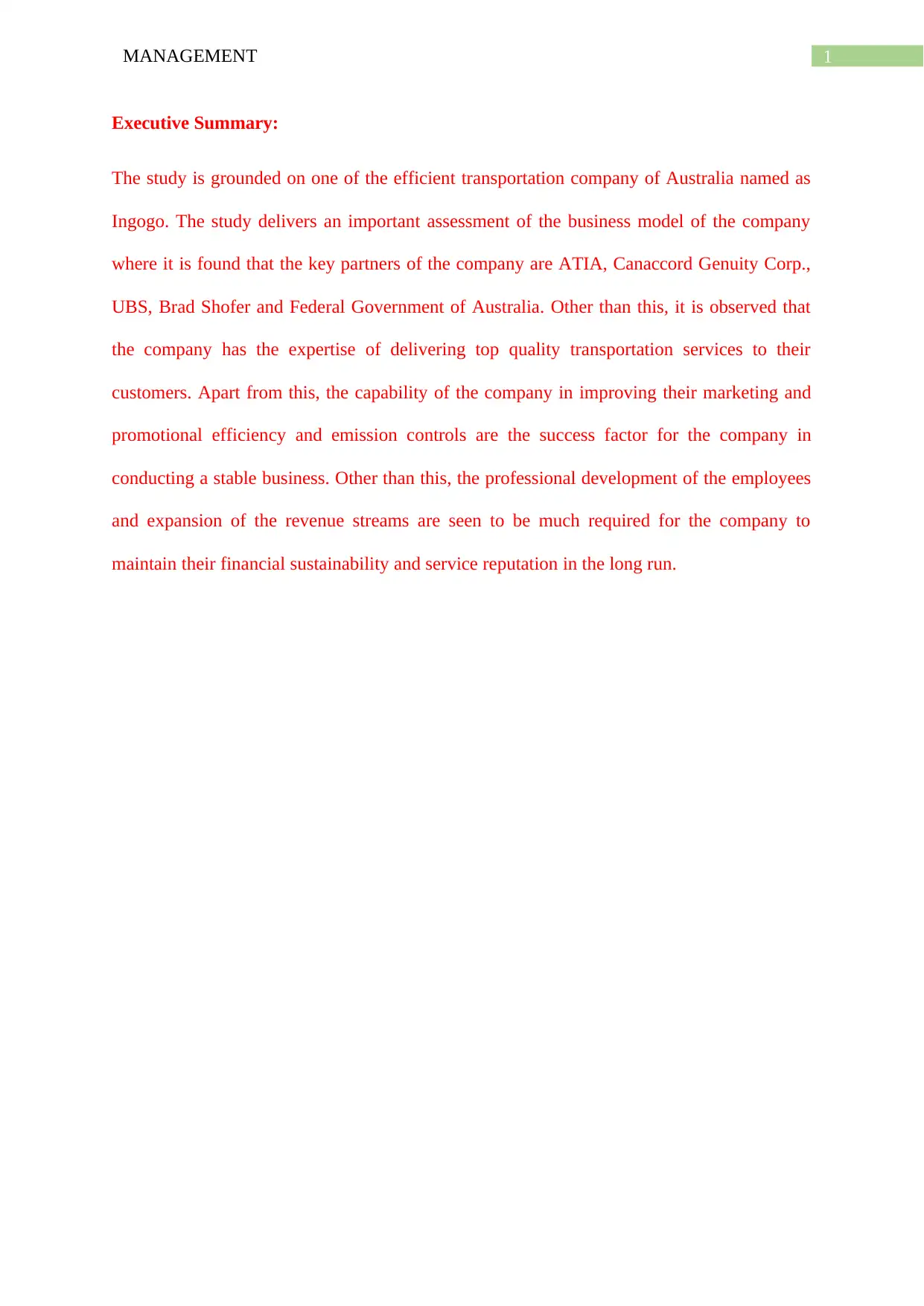
1MANAGEMENT
Executive Summary:
The study is grounded on one of the efficient transportation company of Australia named as
Ingogo. The study delivers an important assessment of the business model of the company
where it is found that the key partners of the company are ATIA, Canaccord Genuity Corp.,
UBS, Brad Shofer and Federal Government of Australia. Other than this, it is observed that
the company has the expertise of delivering top quality transportation services to their
customers. Apart from this, the capability of the company in improving their marketing and
promotional efficiency and emission controls are the success factor for the company in
conducting a stable business. Other than this, the professional development of the employees
and expansion of the revenue streams are seen to be much required for the company to
maintain their financial sustainability and service reputation in the long run.
Executive Summary:
The study is grounded on one of the efficient transportation company of Australia named as
Ingogo. The study delivers an important assessment of the business model of the company
where it is found that the key partners of the company are ATIA, Canaccord Genuity Corp.,
UBS, Brad Shofer and Federal Government of Australia. Other than this, it is observed that
the company has the expertise of delivering top quality transportation services to their
customers. Apart from this, the capability of the company in improving their marketing and
promotional efficiency and emission controls are the success factor for the company in
conducting a stable business. Other than this, the professional development of the employees
and expansion of the revenue streams are seen to be much required for the company to
maintain their financial sustainability and service reputation in the long run.
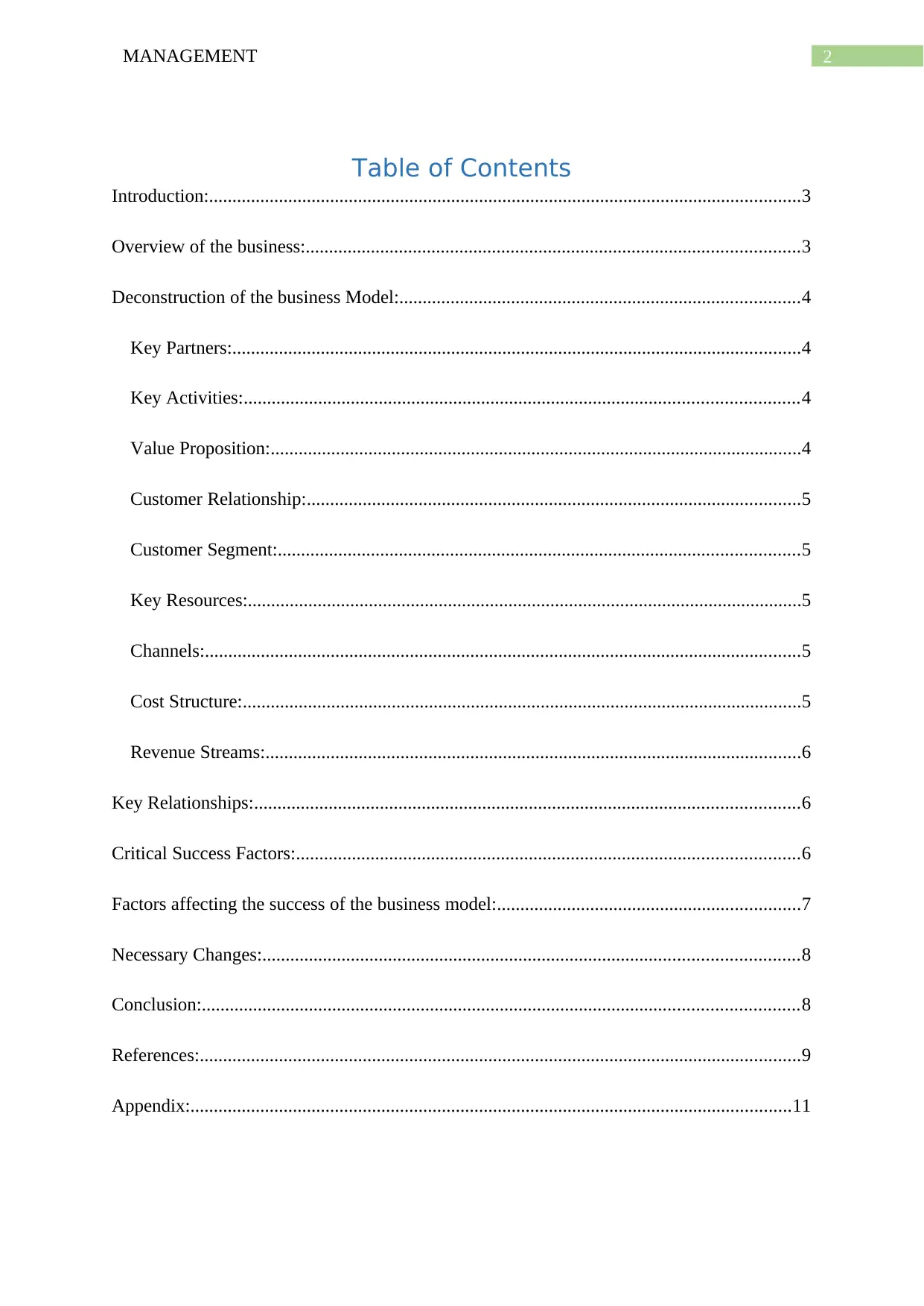
2MANAGEMENT
Table of Contents
Introduction:...............................................................................................................................3
Overview of the business:..........................................................................................................3
Deconstruction of the business Model:......................................................................................4
Key Partners:..........................................................................................................................4
Key Activities:.......................................................................................................................4
Value Proposition:..................................................................................................................4
Customer Relationship:..........................................................................................................5
Customer Segment:................................................................................................................5
Key Resources:.......................................................................................................................5
Channels:................................................................................................................................5
Cost Structure:........................................................................................................................5
Revenue Streams:...................................................................................................................6
Key Relationships:.....................................................................................................................6
Critical Success Factors:............................................................................................................6
Factors affecting the success of the business model:.................................................................7
Necessary Changes:...................................................................................................................8
Conclusion:................................................................................................................................8
References:.................................................................................................................................9
Appendix:.................................................................................................................................11
Table of Contents
Introduction:...............................................................................................................................3
Overview of the business:..........................................................................................................3
Deconstruction of the business Model:......................................................................................4
Key Partners:..........................................................................................................................4
Key Activities:.......................................................................................................................4
Value Proposition:..................................................................................................................4
Customer Relationship:..........................................................................................................5
Customer Segment:................................................................................................................5
Key Resources:.......................................................................................................................5
Channels:................................................................................................................................5
Cost Structure:........................................................................................................................5
Revenue Streams:...................................................................................................................6
Key Relationships:.....................................................................................................................6
Critical Success Factors:............................................................................................................6
Factors affecting the success of the business model:.................................................................7
Necessary Changes:...................................................................................................................8
Conclusion:................................................................................................................................8
References:.................................................................................................................................9
Appendix:.................................................................................................................................11
⊘ This is a preview!⊘
Do you want full access?
Subscribe today to unlock all pages.

Trusted by 1+ million students worldwide
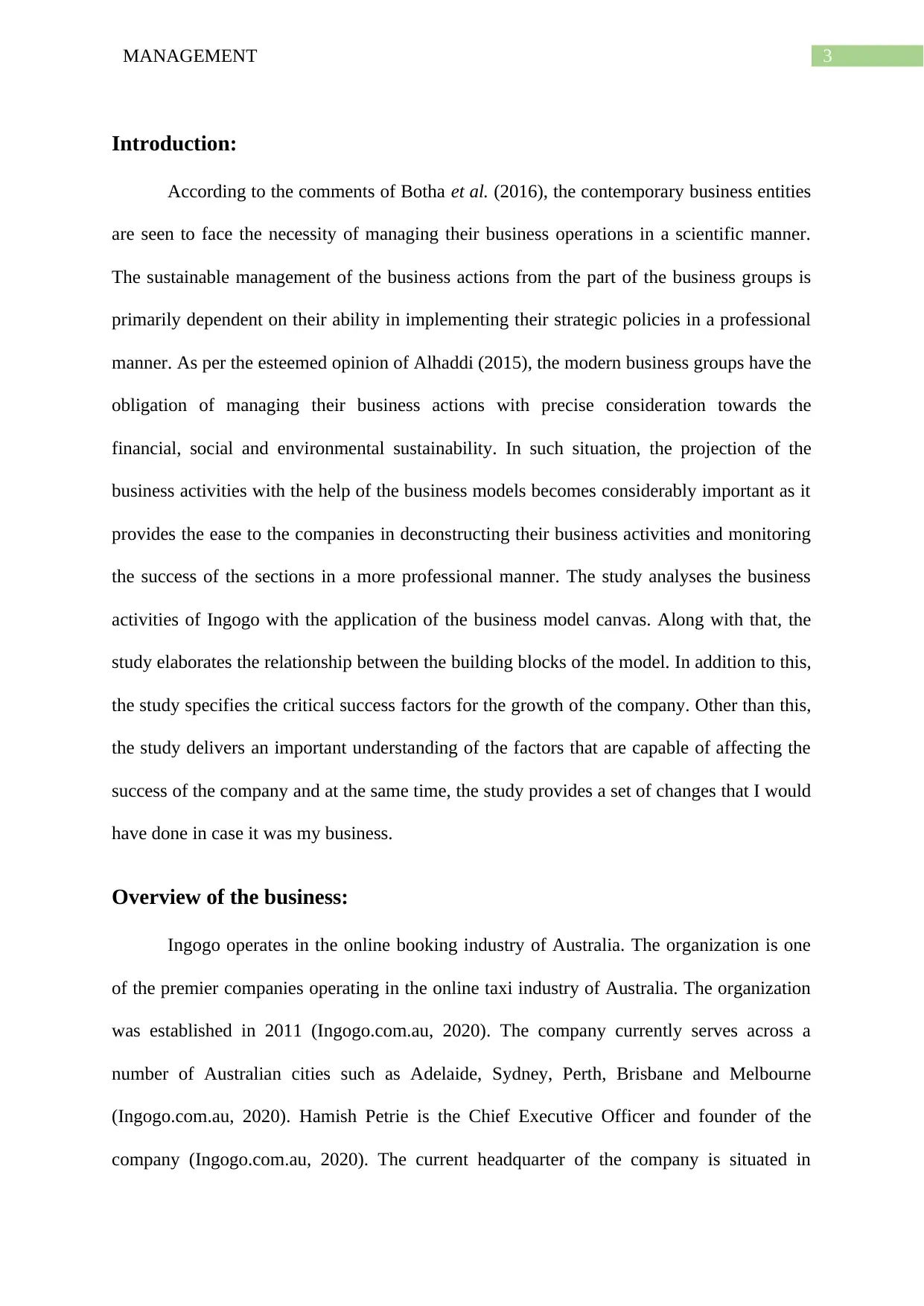
3MANAGEMENT
Introduction:
According to the comments of Botha et al. (2016), the contemporary business entities
are seen to face the necessity of managing their business operations in a scientific manner.
The sustainable management of the business actions from the part of the business groups is
primarily dependent on their ability in implementing their strategic policies in a professional
manner. As per the esteemed opinion of Alhaddi (2015), the modern business groups have the
obligation of managing their business actions with precise consideration towards the
financial, social and environmental sustainability. In such situation, the projection of the
business activities with the help of the business models becomes considerably important as it
provides the ease to the companies in deconstructing their business activities and monitoring
the success of the sections in a more professional manner. The study analyses the business
activities of Ingogo with the application of the business model canvas. Along with that, the
study elaborates the relationship between the building blocks of the model. In addition to this,
the study specifies the critical success factors for the growth of the company. Other than this,
the study delivers an important understanding of the factors that are capable of affecting the
success of the company and at the same time, the study provides a set of changes that I would
have done in case it was my business.
Overview of the business:
Ingogo operates in the online booking industry of Australia. The organization is one
of the premier companies operating in the online taxi industry of Australia. The organization
was established in 2011 (Ingogo.com.au, 2020). The company currently serves across a
number of Australian cities such as Adelaide, Sydney, Perth, Brisbane and Melbourne
(Ingogo.com.au, 2020). Hamish Petrie is the Chief Executive Officer and founder of the
company (Ingogo.com.au, 2020). The current headquarter of the company is situated in
Introduction:
According to the comments of Botha et al. (2016), the contemporary business entities
are seen to face the necessity of managing their business operations in a scientific manner.
The sustainable management of the business actions from the part of the business groups is
primarily dependent on their ability in implementing their strategic policies in a professional
manner. As per the esteemed opinion of Alhaddi (2015), the modern business groups have the
obligation of managing their business actions with precise consideration towards the
financial, social and environmental sustainability. In such situation, the projection of the
business activities with the help of the business models becomes considerably important as it
provides the ease to the companies in deconstructing their business activities and monitoring
the success of the sections in a more professional manner. The study analyses the business
activities of Ingogo with the application of the business model canvas. Along with that, the
study elaborates the relationship between the building blocks of the model. In addition to this,
the study specifies the critical success factors for the growth of the company. Other than this,
the study delivers an important understanding of the factors that are capable of affecting the
success of the company and at the same time, the study provides a set of changes that I would
have done in case it was my business.
Overview of the business:
Ingogo operates in the online booking industry of Australia. The organization is one
of the premier companies operating in the online taxi industry of Australia. The organization
was established in 2011 (Ingogo.com.au, 2020). The company currently serves across a
number of Australian cities such as Adelaide, Sydney, Perth, Brisbane and Melbourne
(Ingogo.com.au, 2020). Hamish Petrie is the Chief Executive Officer and founder of the
company (Ingogo.com.au, 2020). The current headquarter of the company is situated in
Paraphrase This Document
Need a fresh take? Get an instant paraphrase of this document with our AI Paraphraser
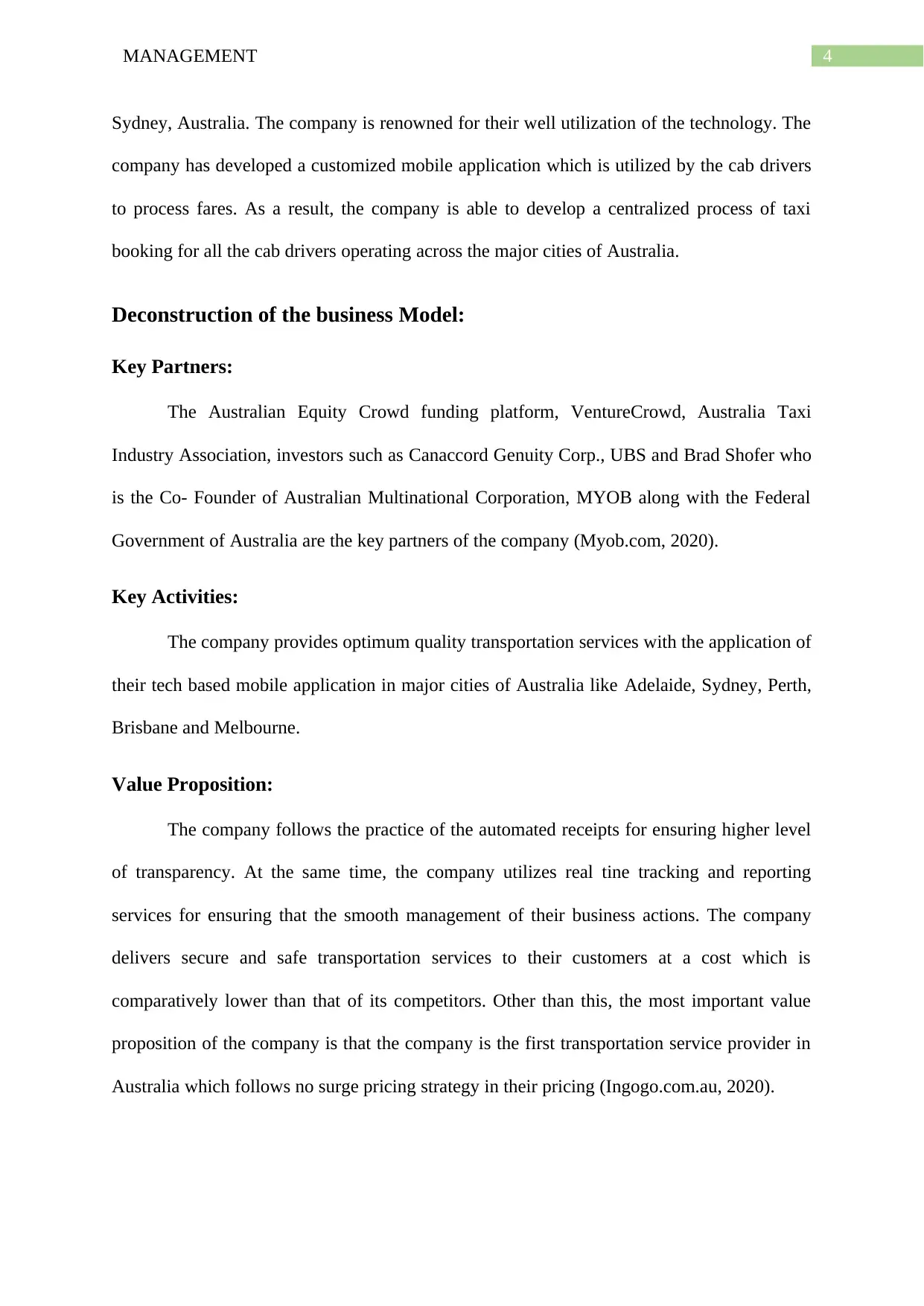
4MANAGEMENT
Sydney, Australia. The company is renowned for their well utilization of the technology. The
company has developed a customized mobile application which is utilized by the cab drivers
to process fares. As a result, the company is able to develop a centralized process of taxi
booking for all the cab drivers operating across the major cities of Australia.
Deconstruction of the business Model:
Key Partners:
The Australian Equity Crowd funding platform, VentureCrowd, Australia Taxi
Industry Association, investors such as Canaccord Genuity Corp., UBS and Brad Shofer who
is the Co- Founder of Australian Multinational Corporation, MYOB along with the Federal
Government of Australia are the key partners of the company (Myob.com, 2020).
Key Activities:
The company provides optimum quality transportation services with the application of
their tech based mobile application in major cities of Australia like Adelaide, Sydney, Perth,
Brisbane and Melbourne.
Value Proposition:
The company follows the practice of the automated receipts for ensuring higher level
of transparency. At the same time, the company utilizes real tine tracking and reporting
services for ensuring that the smooth management of their business actions. The company
delivers secure and safe transportation services to their customers at a cost which is
comparatively lower than that of its competitors. Other than this, the most important value
proposition of the company is that the company is the first transportation service provider in
Australia which follows no surge pricing strategy in their pricing (Ingogo.com.au, 2020).
Sydney, Australia. The company is renowned for their well utilization of the technology. The
company has developed a customized mobile application which is utilized by the cab drivers
to process fares. As a result, the company is able to develop a centralized process of taxi
booking for all the cab drivers operating across the major cities of Australia.
Deconstruction of the business Model:
Key Partners:
The Australian Equity Crowd funding platform, VentureCrowd, Australia Taxi
Industry Association, investors such as Canaccord Genuity Corp., UBS and Brad Shofer who
is the Co- Founder of Australian Multinational Corporation, MYOB along with the Federal
Government of Australia are the key partners of the company (Myob.com, 2020).
Key Activities:
The company provides optimum quality transportation services with the application of
their tech based mobile application in major cities of Australia like Adelaide, Sydney, Perth,
Brisbane and Melbourne.
Value Proposition:
The company follows the practice of the automated receipts for ensuring higher level
of transparency. At the same time, the company utilizes real tine tracking and reporting
services for ensuring that the smooth management of their business actions. The company
delivers secure and safe transportation services to their customers at a cost which is
comparatively lower than that of its competitors. Other than this, the most important value
proposition of the company is that the company is the first transportation service provider in
Australia which follows no surge pricing strategy in their pricing (Ingogo.com.au, 2020).
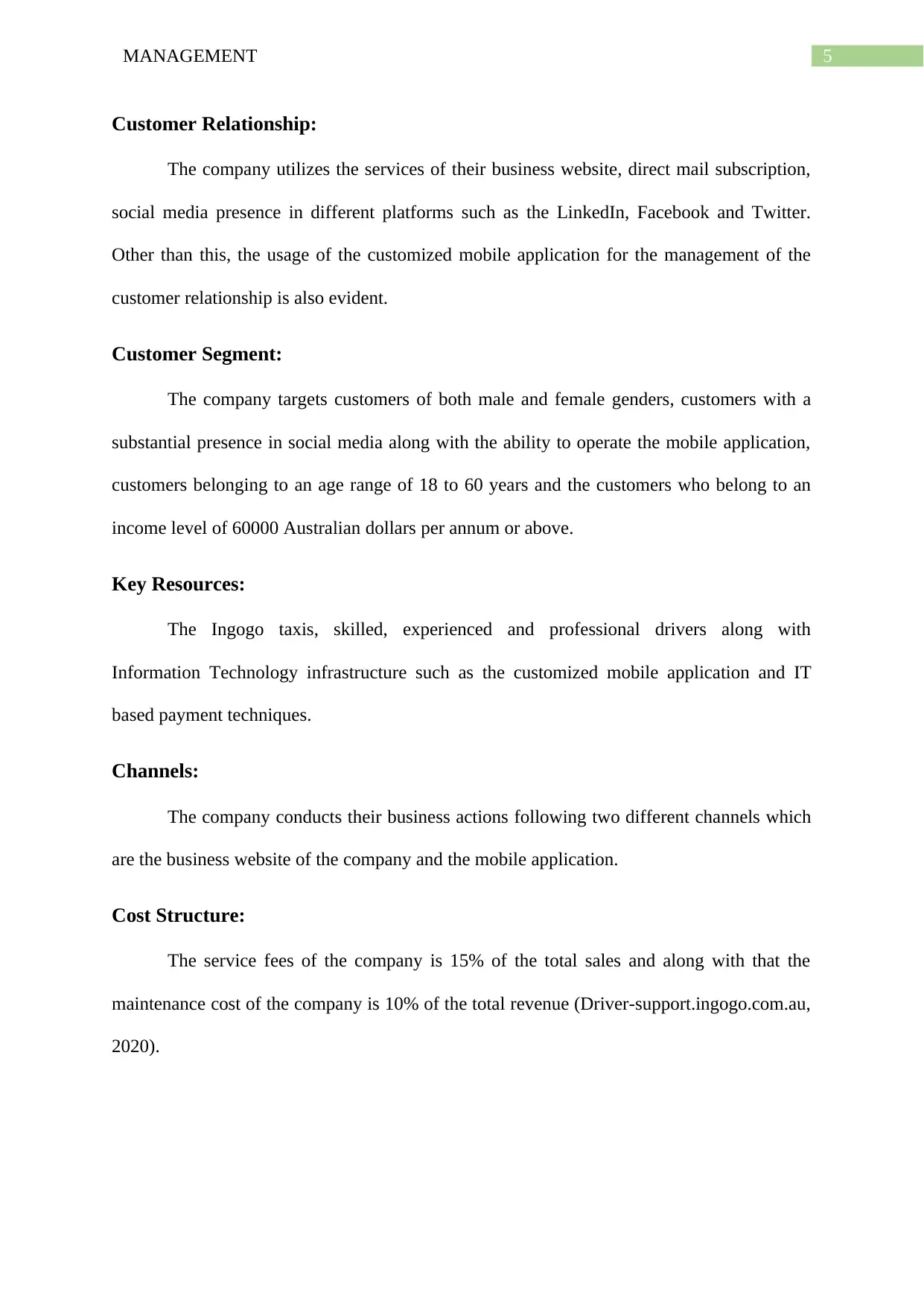
5MANAGEMENT
Customer Relationship:
The company utilizes the services of their business website, direct mail subscription,
social media presence in different platforms such as the LinkedIn, Facebook and Twitter.
Other than this, the usage of the customized mobile application for the management of the
customer relationship is also evident.
Customer Segment:
The company targets customers of both male and female genders, customers with a
substantial presence in social media along with the ability to operate the mobile application,
customers belonging to an age range of 18 to 60 years and the customers who belong to an
income level of 60000 Australian dollars per annum or above.
Key Resources:
The Ingogo taxis, skilled, experienced and professional drivers along with
Information Technology infrastructure such as the customized mobile application and IT
based payment techniques.
Channels:
The company conducts their business actions following two different channels which
are the business website of the company and the mobile application.
Cost Structure:
The service fees of the company is 15% of the total sales and along with that the
maintenance cost of the company is 10% of the total revenue (Driver-support.ingogo.com.au,
2020).
Customer Relationship:
The company utilizes the services of their business website, direct mail subscription,
social media presence in different platforms such as the LinkedIn, Facebook and Twitter.
Other than this, the usage of the customized mobile application for the management of the
customer relationship is also evident.
Customer Segment:
The company targets customers of both male and female genders, customers with a
substantial presence in social media along with the ability to operate the mobile application,
customers belonging to an age range of 18 to 60 years and the customers who belong to an
income level of 60000 Australian dollars per annum or above.
Key Resources:
The Ingogo taxis, skilled, experienced and professional drivers along with
Information Technology infrastructure such as the customized mobile application and IT
based payment techniques.
Channels:
The company conducts their business actions following two different channels which
are the business website of the company and the mobile application.
Cost Structure:
The service fees of the company is 15% of the total sales and along with that the
maintenance cost of the company is 10% of the total revenue (Driver-support.ingogo.com.au,
2020).
⊘ This is a preview!⊘
Do you want full access?
Subscribe today to unlock all pages.

Trusted by 1+ million students worldwide
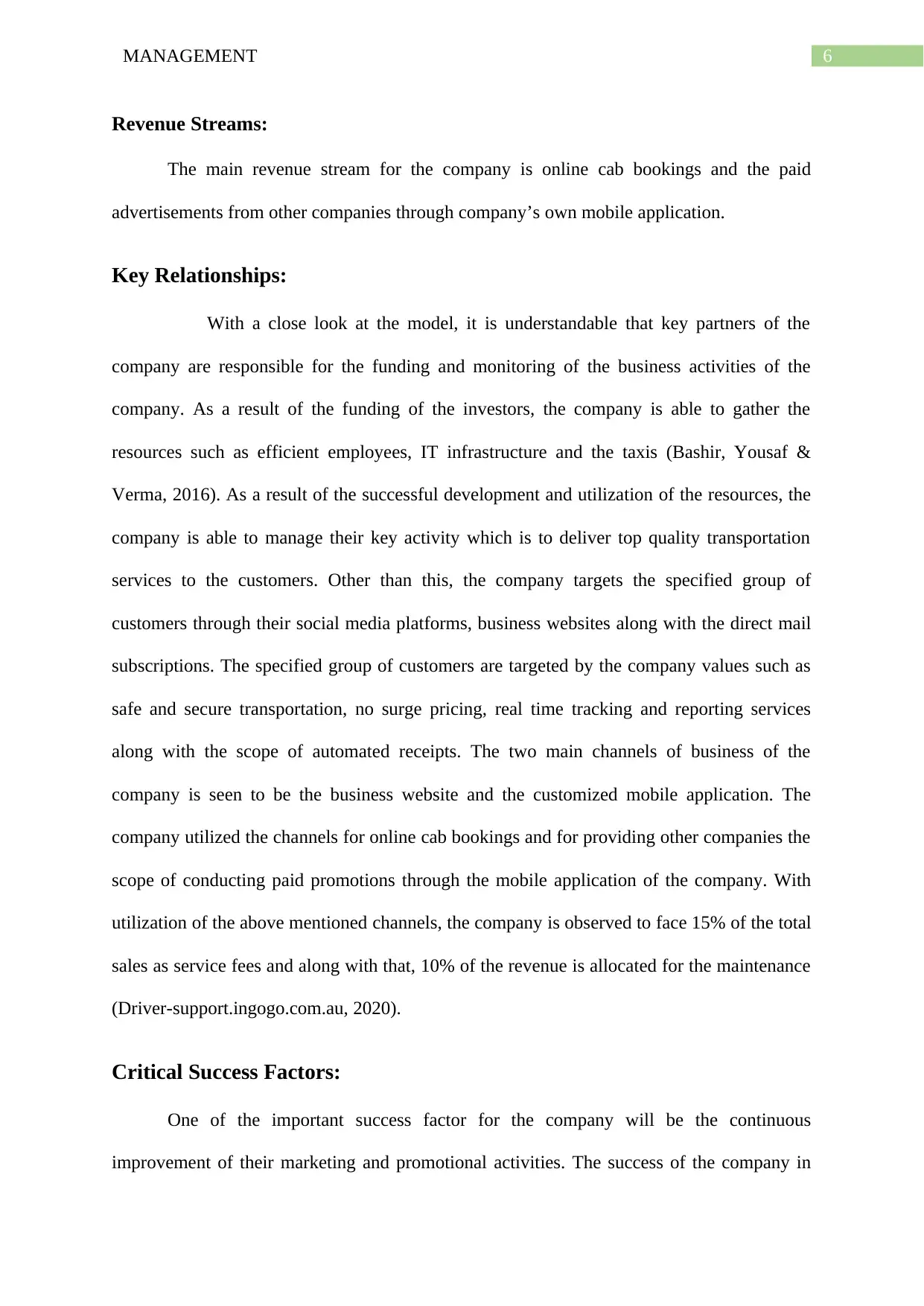
6MANAGEMENT
Revenue Streams:
The main revenue stream for the company is online cab bookings and the paid
advertisements from other companies through company’s own mobile application.
Key Relationships:
With a close look at the model, it is understandable that key partners of the
company are responsible for the funding and monitoring of the business activities of the
company. As a result of the funding of the investors, the company is able to gather the
resources such as efficient employees, IT infrastructure and the taxis (Bashir, Yousaf &
Verma, 2016). As a result of the successful development and utilization of the resources, the
company is able to manage their key activity which is to deliver top quality transportation
services to the customers. Other than this, the company targets the specified group of
customers through their social media platforms, business websites along with the direct mail
subscriptions. The specified group of customers are targeted by the company values such as
safe and secure transportation, no surge pricing, real time tracking and reporting services
along with the scope of automated receipts. The two main channels of business of the
company is seen to be the business website and the customized mobile application. The
company utilized the channels for online cab bookings and for providing other companies the
scope of conducting paid promotions through the mobile application of the company. With
utilization of the above mentioned channels, the company is observed to face 15% of the total
sales as service fees and along with that, 10% of the revenue is allocated for the maintenance
(Driver-support.ingogo.com.au, 2020).
Critical Success Factors:
One of the important success factor for the company will be the continuous
improvement of their marketing and promotional activities. The success of the company in
Revenue Streams:
The main revenue stream for the company is online cab bookings and the paid
advertisements from other companies through company’s own mobile application.
Key Relationships:
With a close look at the model, it is understandable that key partners of the
company are responsible for the funding and monitoring of the business activities of the
company. As a result of the funding of the investors, the company is able to gather the
resources such as efficient employees, IT infrastructure and the taxis (Bashir, Yousaf &
Verma, 2016). As a result of the successful development and utilization of the resources, the
company is able to manage their key activity which is to deliver top quality transportation
services to the customers. Other than this, the company targets the specified group of
customers through their social media platforms, business websites along with the direct mail
subscriptions. The specified group of customers are targeted by the company values such as
safe and secure transportation, no surge pricing, real time tracking and reporting services
along with the scope of automated receipts. The two main channels of business of the
company is seen to be the business website and the customized mobile application. The
company utilized the channels for online cab bookings and for providing other companies the
scope of conducting paid promotions through the mobile application of the company. With
utilization of the above mentioned channels, the company is observed to face 15% of the total
sales as service fees and along with that, 10% of the revenue is allocated for the maintenance
(Driver-support.ingogo.com.au, 2020).
Critical Success Factors:
One of the important success factor for the company will be the continuous
improvement of their marketing and promotional activities. The success of the company in
Paraphrase This Document
Need a fresh take? Get an instant paraphrase of this document with our AI Paraphraser
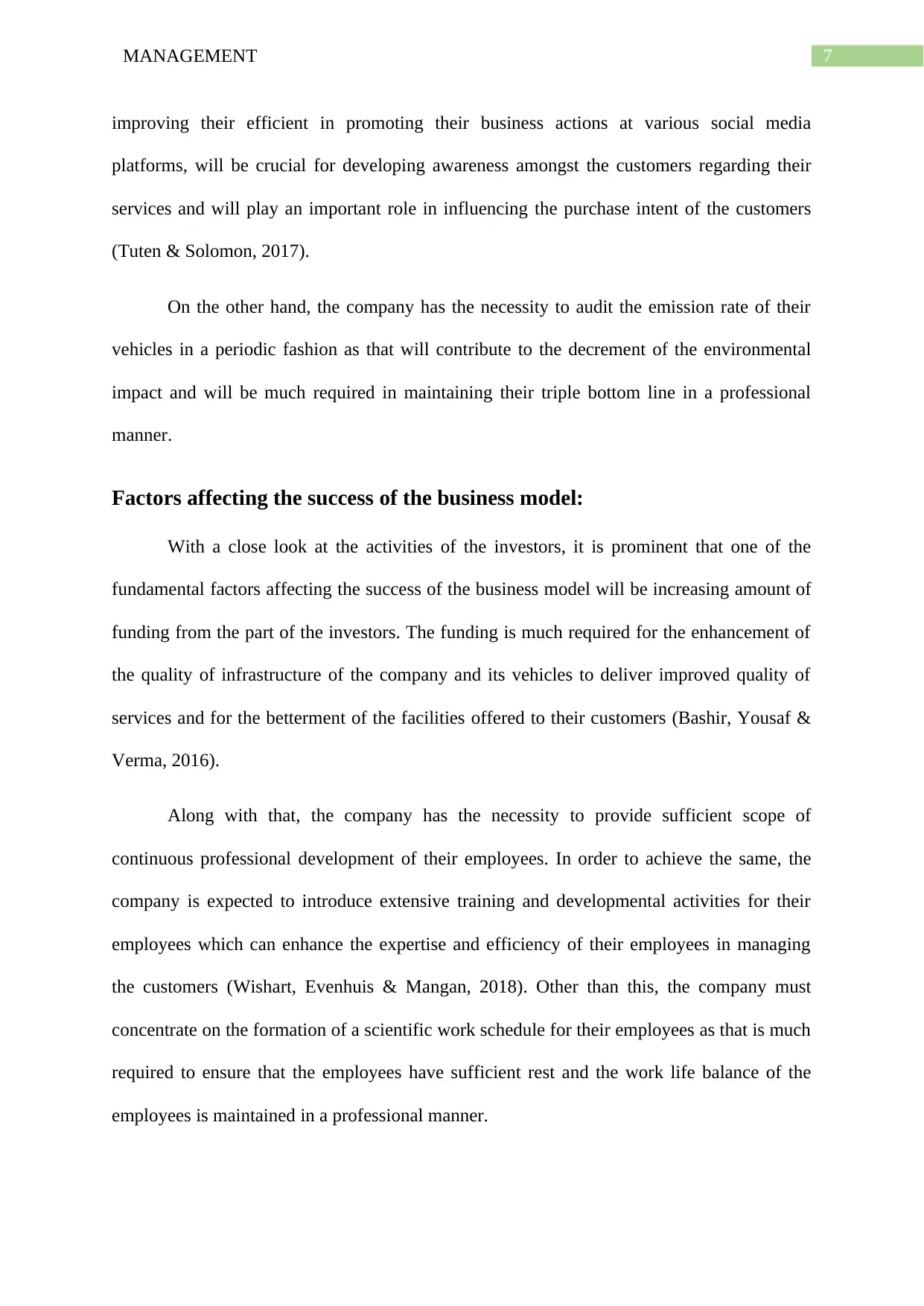
7MANAGEMENT
improving their efficient in promoting their business actions at various social media
platforms, will be crucial for developing awareness amongst the customers regarding their
services and will play an important role in influencing the purchase intent of the customers
(Tuten & Solomon, 2017).
On the other hand, the company has the necessity to audit the emission rate of their
vehicles in a periodic fashion as that will contribute to the decrement of the environmental
impact and will be much required in maintaining their triple bottom line in a professional
manner.
Factors affecting the success of the business model:
With a close look at the activities of the investors, it is prominent that one of the
fundamental factors affecting the success of the business model will be increasing amount of
funding from the part of the investors. The funding is much required for the enhancement of
the quality of infrastructure of the company and its vehicles to deliver improved quality of
services and for the betterment of the facilities offered to their customers (Bashir, Yousaf &
Verma, 2016).
Along with that, the company has the necessity to provide sufficient scope of
continuous professional development of their employees. In order to achieve the same, the
company is expected to introduce extensive training and developmental activities for their
employees which can enhance the expertise and efficiency of their employees in managing
the customers (Wishart, Evenhuis & Mangan, 2018). Other than this, the company must
concentrate on the formation of a scientific work schedule for their employees as that is much
required to ensure that the employees have sufficient rest and the work life balance of the
employees is maintained in a professional manner.
improving their efficient in promoting their business actions at various social media
platforms, will be crucial for developing awareness amongst the customers regarding their
services and will play an important role in influencing the purchase intent of the customers
(Tuten & Solomon, 2017).
On the other hand, the company has the necessity to audit the emission rate of their
vehicles in a periodic fashion as that will contribute to the decrement of the environmental
impact and will be much required in maintaining their triple bottom line in a professional
manner.
Factors affecting the success of the business model:
With a close look at the activities of the investors, it is prominent that one of the
fundamental factors affecting the success of the business model will be increasing amount of
funding from the part of the investors. The funding is much required for the enhancement of
the quality of infrastructure of the company and its vehicles to deliver improved quality of
services and for the betterment of the facilities offered to their customers (Bashir, Yousaf &
Verma, 2016).
Along with that, the company has the necessity to provide sufficient scope of
continuous professional development of their employees. In order to achieve the same, the
company is expected to introduce extensive training and developmental activities for their
employees which can enhance the expertise and efficiency of their employees in managing
the customers (Wishart, Evenhuis & Mangan, 2018). Other than this, the company must
concentrate on the formation of a scientific work schedule for their employees as that is much
required to ensure that the employees have sufficient rest and the work life balance of the
employees is maintained in a professional manner.
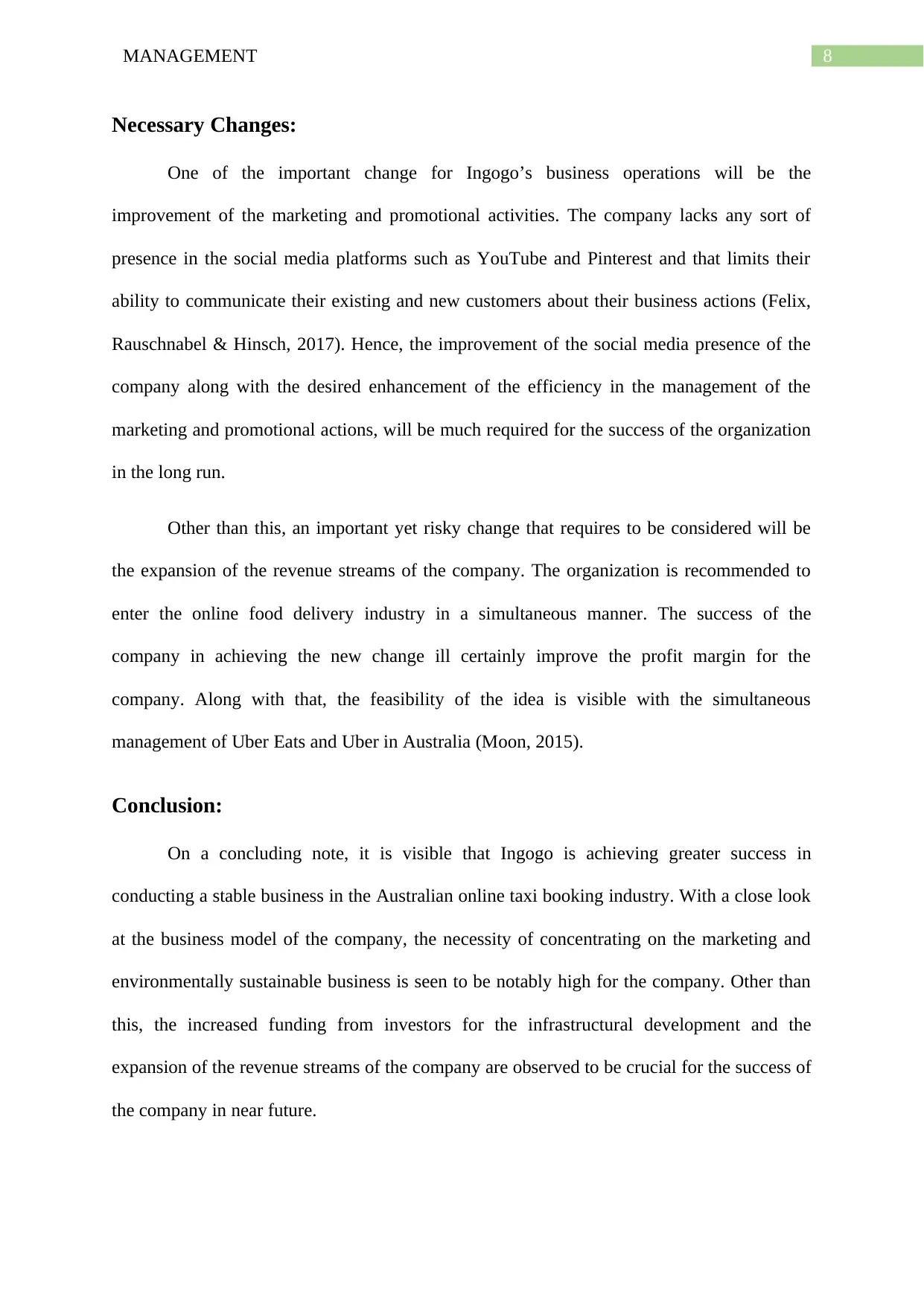
8MANAGEMENT
Necessary Changes:
One of the important change for Ingogo’s business operations will be the
improvement of the marketing and promotional activities. The company lacks any sort of
presence in the social media platforms such as YouTube and Pinterest and that limits their
ability to communicate their existing and new customers about their business actions (Felix,
Rauschnabel & Hinsch, 2017). Hence, the improvement of the social media presence of the
company along with the desired enhancement of the efficiency in the management of the
marketing and promotional actions, will be much required for the success of the organization
in the long run.
Other than this, an important yet risky change that requires to be considered will be
the expansion of the revenue streams of the company. The organization is recommended to
enter the online food delivery industry in a simultaneous manner. The success of the
company in achieving the new change ill certainly improve the profit margin for the
company. Along with that, the feasibility of the idea is visible with the simultaneous
management of Uber Eats and Uber in Australia (Moon, 2015).
Conclusion:
On a concluding note, it is visible that Ingogo is achieving greater success in
conducting a stable business in the Australian online taxi booking industry. With a close look
at the business model of the company, the necessity of concentrating on the marketing and
environmentally sustainable business is seen to be notably high for the company. Other than
this, the increased funding from investors for the infrastructural development and the
expansion of the revenue streams of the company are observed to be crucial for the success of
the company in near future.
Necessary Changes:
One of the important change for Ingogo’s business operations will be the
improvement of the marketing and promotional activities. The company lacks any sort of
presence in the social media platforms such as YouTube and Pinterest and that limits their
ability to communicate their existing and new customers about their business actions (Felix,
Rauschnabel & Hinsch, 2017). Hence, the improvement of the social media presence of the
company along with the desired enhancement of the efficiency in the management of the
marketing and promotional actions, will be much required for the success of the organization
in the long run.
Other than this, an important yet risky change that requires to be considered will be
the expansion of the revenue streams of the company. The organization is recommended to
enter the online food delivery industry in a simultaneous manner. The success of the
company in achieving the new change ill certainly improve the profit margin for the
company. Along with that, the feasibility of the idea is visible with the simultaneous
management of Uber Eats and Uber in Australia (Moon, 2015).
Conclusion:
On a concluding note, it is visible that Ingogo is achieving greater success in
conducting a stable business in the Australian online taxi booking industry. With a close look
at the business model of the company, the necessity of concentrating on the marketing and
environmentally sustainable business is seen to be notably high for the company. Other than
this, the increased funding from investors for the infrastructural development and the
expansion of the revenue streams of the company are observed to be crucial for the success of
the company in near future.
⊘ This is a preview!⊘
Do you want full access?
Subscribe today to unlock all pages.

Trusted by 1+ million students worldwide
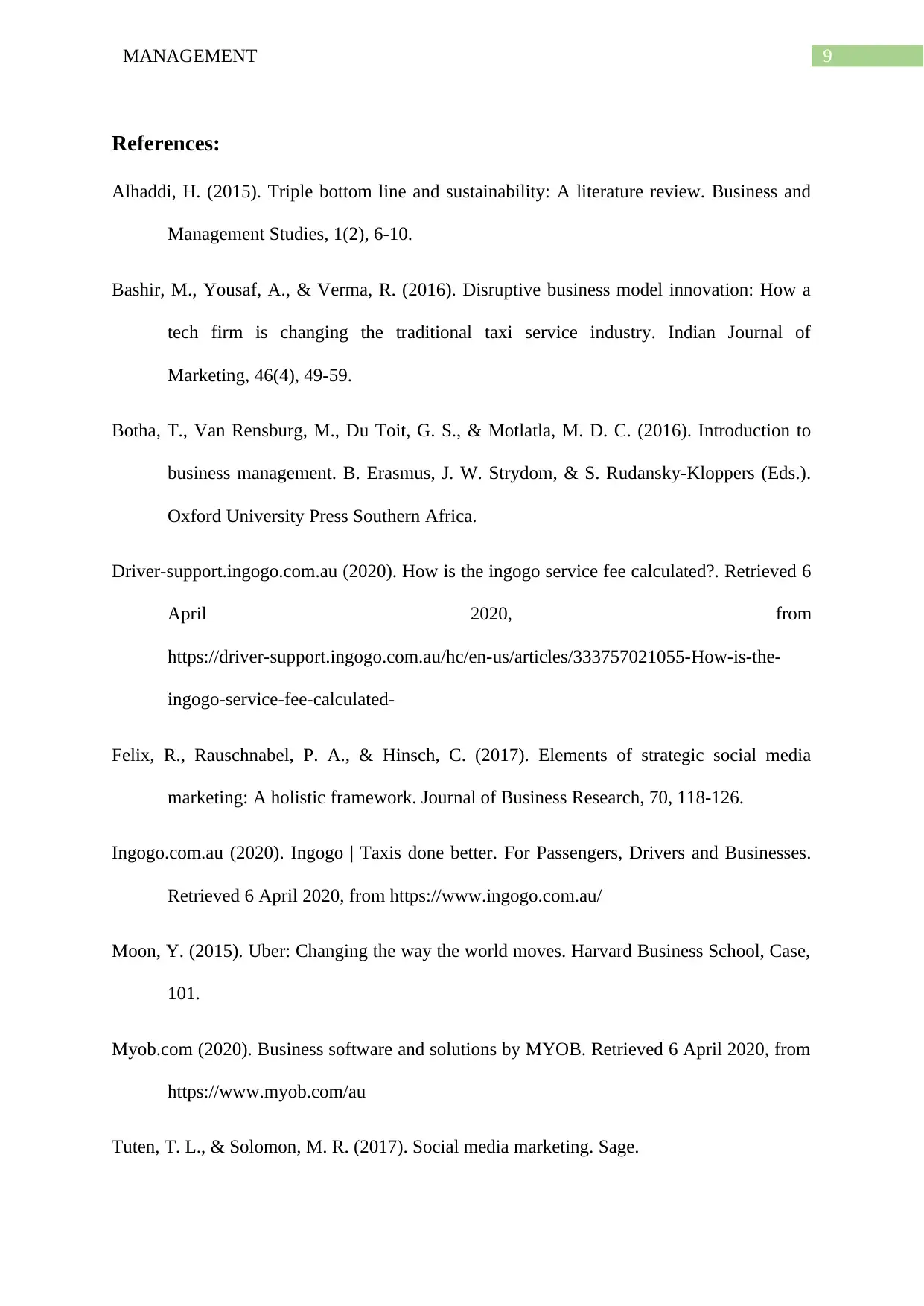
9MANAGEMENT
References:
Alhaddi, H. (2015). Triple bottom line and sustainability: A literature review. Business and
Management Studies, 1(2), 6-10.
Bashir, M., Yousaf, A., & Verma, R. (2016). Disruptive business model innovation: How a
tech firm is changing the traditional taxi service industry. Indian Journal of
Marketing, 46(4), 49-59.
Botha, T., Van Rensburg, M., Du Toit, G. S., & Motlatla, M. D. C. (2016). Introduction to
business management. B. Erasmus, J. W. Strydom, & S. Rudansky-Kloppers (Eds.).
Oxford University Press Southern Africa.
Driver-support.ingogo.com.au (2020). How is the ingogo service fee calculated?. Retrieved 6
April 2020, from
https://driver-support.ingogo.com.au/hc/en-us/articles/333757021055-How-is-the-
ingogo-service-fee-calculated-
Felix, R., Rauschnabel, P. A., & Hinsch, C. (2017). Elements of strategic social media
marketing: A holistic framework. Journal of Business Research, 70, 118-126.
Ingogo.com.au (2020). Ingogo | Taxis done better. For Passengers, Drivers and Businesses.
Retrieved 6 April 2020, from https://www.ingogo.com.au/
Moon, Y. (2015). Uber: Changing the way the world moves. Harvard Business School, Case,
101.
Myob.com (2020). Business software and solutions by MYOB. Retrieved 6 April 2020, from
https://www.myob.com/au
Tuten, T. L., & Solomon, M. R. (2017). Social media marketing. Sage.
References:
Alhaddi, H. (2015). Triple bottom line and sustainability: A literature review. Business and
Management Studies, 1(2), 6-10.
Bashir, M., Yousaf, A., & Verma, R. (2016). Disruptive business model innovation: How a
tech firm is changing the traditional taxi service industry. Indian Journal of
Marketing, 46(4), 49-59.
Botha, T., Van Rensburg, M., Du Toit, G. S., & Motlatla, M. D. C. (2016). Introduction to
business management. B. Erasmus, J. W. Strydom, & S. Rudansky-Kloppers (Eds.).
Oxford University Press Southern Africa.
Driver-support.ingogo.com.au (2020). How is the ingogo service fee calculated?. Retrieved 6
April 2020, from
https://driver-support.ingogo.com.au/hc/en-us/articles/333757021055-How-is-the-
ingogo-service-fee-calculated-
Felix, R., Rauschnabel, P. A., & Hinsch, C. (2017). Elements of strategic social media
marketing: A holistic framework. Journal of Business Research, 70, 118-126.
Ingogo.com.au (2020). Ingogo | Taxis done better. For Passengers, Drivers and Businesses.
Retrieved 6 April 2020, from https://www.ingogo.com.au/
Moon, Y. (2015). Uber: Changing the way the world moves. Harvard Business School, Case,
101.
Myob.com (2020). Business software and solutions by MYOB. Retrieved 6 April 2020, from
https://www.myob.com/au
Tuten, T. L., & Solomon, M. R. (2017). Social media marketing. Sage.
Paraphrase This Document
Need a fresh take? Get an instant paraphrase of this document with our AI Paraphraser
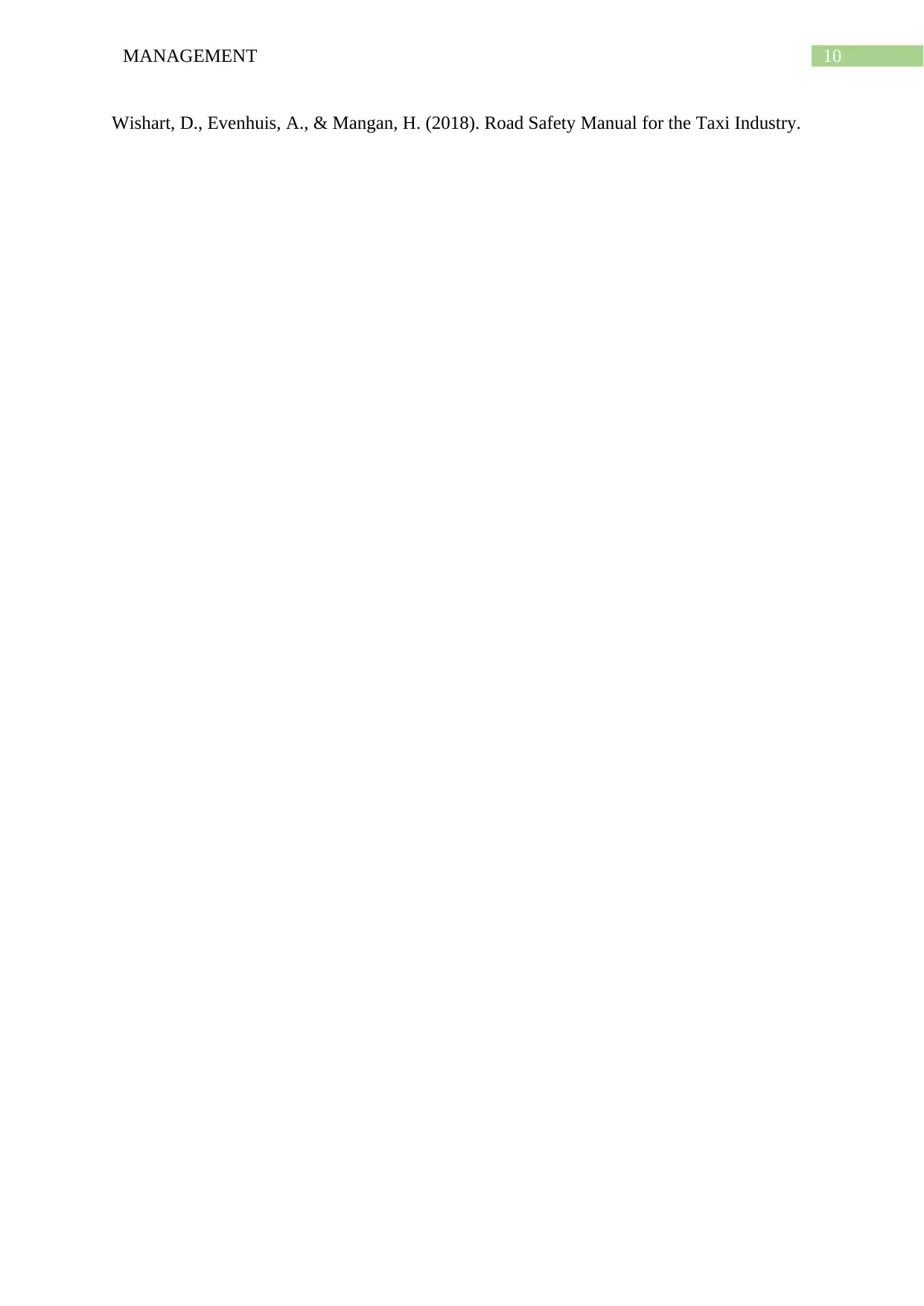
10MANAGEMENT
Wishart, D., Evenhuis, A., & Mangan, H. (2018). Road Safety Manual for the Taxi Industry.
Wishart, D., Evenhuis, A., & Mangan, H. (2018). Road Safety Manual for the Taxi Industry.
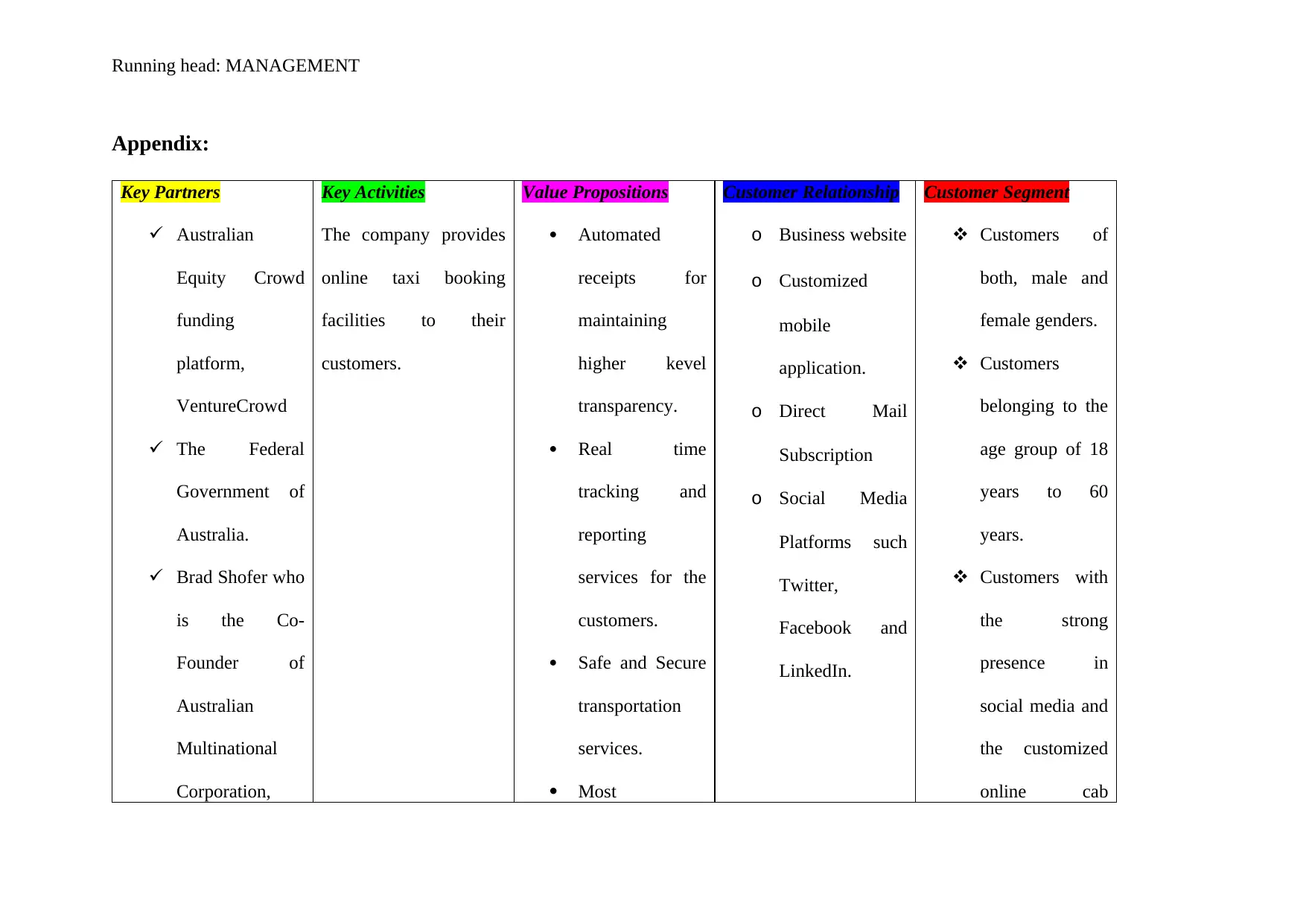
Running head: MANAGEMENT
Appendix:
Key Partners
Australian
Equity Crowd
funding
platform,
VentureCrowd
The Federal
Government of
Australia.
Brad Shofer who
is the Co-
Founder of
Australian
Multinational
Corporation,
Key Activities
The company provides
online taxi booking
facilities to their
customers.
Value Propositions
Automated
receipts for
maintaining
higher kevel
transparency.
Real time
tracking and
reporting
services for the
customers.
Safe and Secure
transportation
services.
Most
Customer Relationship
o Business website
o Customized
mobile
application.
o Direct Mail
Subscription
o Social Media
Platforms such
Twitter,
Facebook and
LinkedIn.
Customer Segment
Customers of
both, male and
female genders.
Customers
belonging to the
age group of 18
years to 60
years.
Customers with
the strong
presence in
social media and
the customized
online cab
Appendix:
Key Partners
Australian
Equity Crowd
funding
platform,
VentureCrowd
The Federal
Government of
Australia.
Brad Shofer who
is the Co-
Founder of
Australian
Multinational
Corporation,
Key Activities
The company provides
online taxi booking
facilities to their
customers.
Value Propositions
Automated
receipts for
maintaining
higher kevel
transparency.
Real time
tracking and
reporting
services for the
customers.
Safe and Secure
transportation
services.
Most
Customer Relationship
o Business website
o Customized
mobile
application.
o Direct Mail
Subscription
o Social Media
Platforms such
Twitter,
Facebook and
LinkedIn.
Customer Segment
Customers of
both, male and
female genders.
Customers
belonging to the
age group of 18
years to 60
years.
Customers with
the strong
presence in
social media and
the customized
online cab
⊘ This is a preview!⊘
Do you want full access?
Subscribe today to unlock all pages.

Trusted by 1+ million students worldwide
1 out of 15
Related Documents
Your All-in-One AI-Powered Toolkit for Academic Success.
+13062052269
info@desklib.com
Available 24*7 on WhatsApp / Email
![[object Object]](/_next/static/media/star-bottom.7253800d.svg)
Unlock your academic potential
Copyright © 2020–2025 A2Z Services. All Rights Reserved. Developed and managed by ZUCOL.



